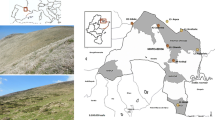Summary
Acidification of raw humus soil in coniferous forest areas leads to characteristic changes in the microarthropod community. Certain species are “calciophilic” and decrease in abundance, while others are “acidophilic” and increase in abundance. The simplest explanation for these changes is that population levels are directly related to soil pH. This hypothesis was tested by growing small populations of selected species in monoculture at different pH levels. Three acidophilic species were tested, the collembolan Mesaphorura yosii, the oribatid mite Nothrus silvestris, and the astigmatid mite Schwiebea cf. lebruni. A slightly calciophilic collembolan, Isotomiella minor, was also included. For all species, population growth was lowest in acidified raw humus. Even acidophilic species seem to have an optimum at a high pH. It is assumed that their success in low-pH soils is due to their ability to compete under these conditions. Competition may be a key factor in microarthropod reactions to soil acidification.
Similar content being viewed by others
References
Anderson JM (1978) Competition between two unrelated species of soil Cryptostigmata (Acari) in experimental microcosms. J Anim Ecol 47:787–803
Christiansen K (1967) Competition between collembolan species in culture jars. Rev Ecol Biol Sol 4:439–462
Hågvar S (1982) Collembola in Norwegian coniferous forest soils: I. Relations to plant communities and soil fertility. Pedobiologia 24:255–296
Hågvar S (1984a) Effects of liming and artificial acid rain on Collembola and Protura in coniferous forest. Pedobiologia 27:341–354
Hågvar S (1984b) Six common mite species (Acari) in Norwegian coniferous forest soils: Relations to vegetation types and soil characteristics. Pedobiologia 27:355–364
Hågvar S (1984c) Ecological studies of microarthropods in forest soils, with emphasis on relations to soil acidity. Doctoral dissertation, University of Oslo
Hågvar S (1987a) Effects of artificial acid precipitation and liming on forest microarthropods. In: Striganova BR (ed) Soil fauna and soil fertility. Proceedings of the 9th International Colloquium on Soil Zoology, Moscow, August 1985, pp 661–668. Moscow “Nauka”
Hågvar S (1987b) Why do collemboles and mites react to changes in soil acidity? Entomol Medd 55:115–119
Hågvar S (1987 c) What is the importance of soil acidity for the soil fauna? Fauna 40:64–72 (in Norwegian, English summary and text on figures and tables)
Hågvar S (1988a) Acid rain and soil fauna. In: Iturrondobeitia JC (ed) Biologia Ambiental, Tomo I. Proceedings of the Second World Basque Congress, Bilbao, November 1987, pp 191–201. Universidad del Pais Vasco, Bilbao
Hågvar S (1988b) Decomposition studies in an easily-constructed microcosm: Effects of microarthropods and varying soil pH. Pedobiologia 31: 293–303
Hågvar S, Abrahamsen G (1980) Colomisation by Enchytraeidae, Collembola and Acari in sterile soil samples with adjusted pH levels. Oikos 34:245–258
Hågvar S, Abrahamsen G (1984) Collembola in Norwegian coniferous forest soils: III. Relations to soil chemistry. Pedobiologia 27:331–339
Hågvar S, Amundsen T (1981) Effects of liming and artificial acid rain on the mite (Acari) fauna in coniferous forest. Oikos 37:7–20
Hågvar S, Kjøndal BR (1981) Effects of artificial acid rain on the microarthropod fauna in decomposing birch leaves. Pedobiologia 22:409–422
Huhta V, Hyvönen R, Koskenniemi A, Vilkamaa P (1983) Role of pH in the effect of fertilization on Nematoda, Oligochaeta and microarthropods. In: Lebrun P, André HM, De Medts A, Grégoire-Wibo C, Wauthy G (eds) New trends in soil biology. Proceedings of the 8th International Colloquium on Soil Zoology, Louvain-la-Neuve, Belgium, 30 August–2 September 1982, pp 61–73. Dieu-Brichart, Ottignies-Louvain-la-Neuve
Koskenniemi A, Huhta V (1986) Effects of fertilization and manipulation of pH on mite (Acari) populations of coniferous forest soil. Rev Ecol Biol Sol 23:271–286
Nygard J, Solberg J (1985) Laboratory study on competition between four soil-living species of Collembola. Thesis, University of Oslo (in Norwegian)
Vilkamaa P, Huhta V (1986) Effects of fertilization and pH on communities of Collembola in pine forest soil. Ann Zool Fenn 23:167–174
Author information
Authors and Affiliations
Additional information
Dedicated to the late Prof. Dr. W. Kühnelt
Rights and permissions
About this article
Cite this article
Hågvar, S. Reactions to soil acidification in microarthropods: Is competition a key factor?. Biol Fertil Soils 9, 178–181 (1990). https://doi.org/10.1007/BF00335804
Received:
Issue Date:
DOI: https://doi.org/10.1007/BF00335804




